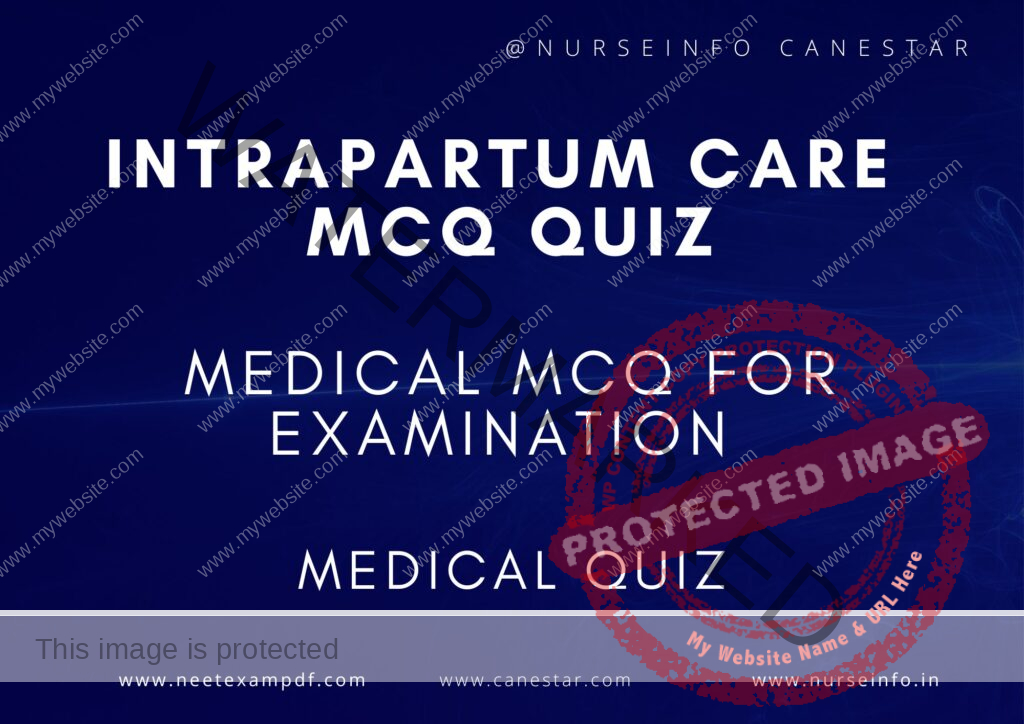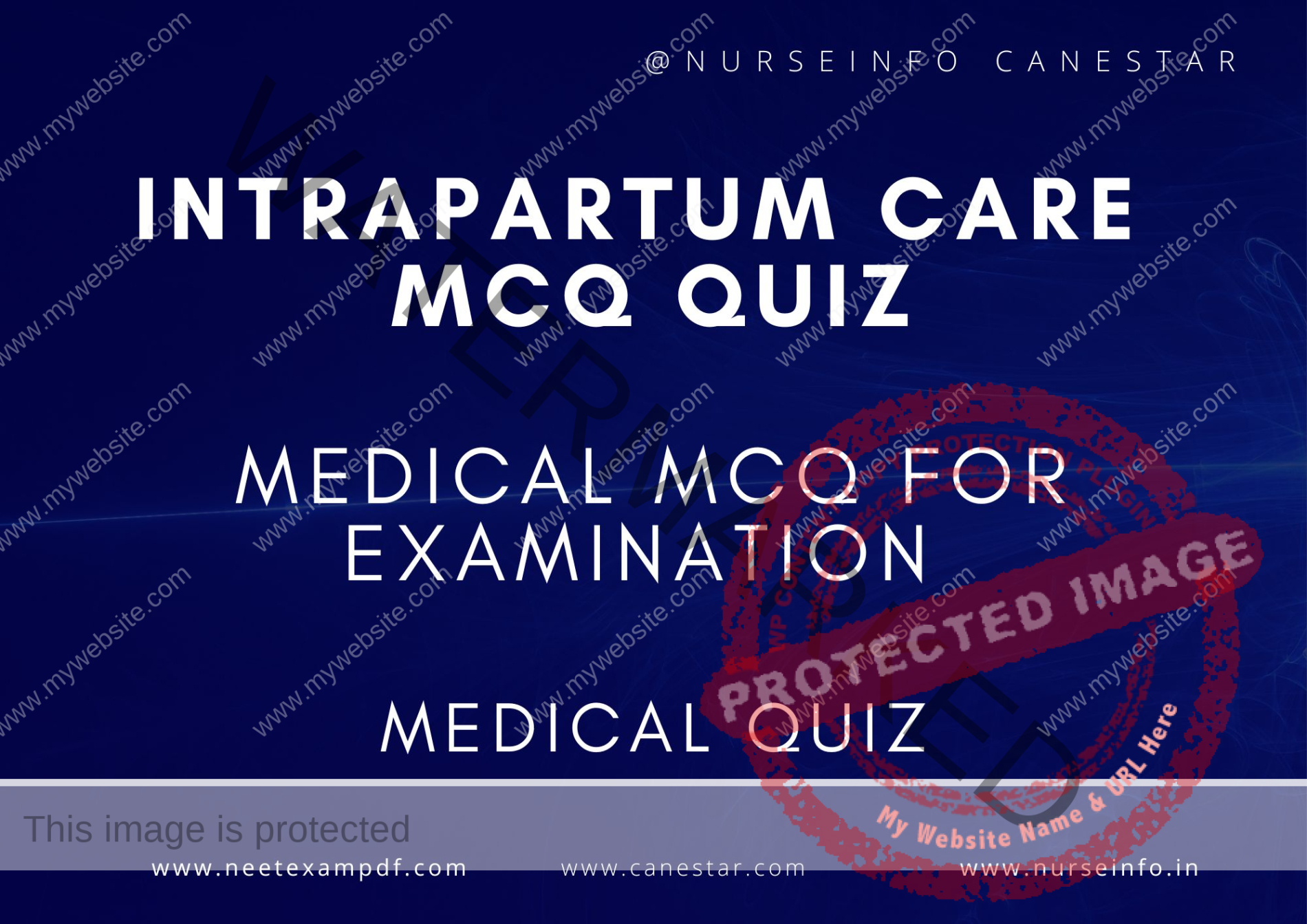MULTIPLE CHOICE QUESTIONS ON INTRAPARTUM CARE QUIZ – MCQS WITH RATIONALE ANSWER – OBG Midwifery & Obstetrics MCQ QUESTIONS
MCQ FOR INTRAPARTUM CARE QUIZ
These mcqs are prepared exclusively for medical professionals for exam preparation. MCQ is helpful to remember the concept on intrapartum care mcq quiz. This multiple choice questions are helpful for preparation for DHA, PROMETRIC, MOH, HAAD, NCLEX, Medical and Nursing EXAMINATION
INTRAPARTUM CARE MCQ QUIZ
1. What is the most common cause of postpartum hemorrhage?
A. Uterine atony
B. Retained placenta
C. Vaginal lacerations
D. Coagulopathy
Answer: A. Uterine atony
Rationale: Uterine atony, the failure of the uterus to contract effectively after delivery, is the most common cause of postpartum hemorrhage.
2. Which of the following is the primary purpose of continuous electronic fetal monitoring (EFM) during labor?
A. To measure maternal blood pressure
B. To assess fetal heart rate and uterine contractions
C. To monitor maternal temperature
D. To check amniotic fluid levels
Answer: B. To assess fetal heart rate and uterine contractions
Rationale: Continuous EFM is used to monitor the fetal heart rate and uterine contractions to identify signs of fetal distress during labor.
3. What is the first stage of labor characterized by?
A. Cervical dilation and effacement
B. Delivery of the baby
C. Delivery of the placenta
D. Uterine involution
Answer: A. Cervical dilation and effacement
Rationale: The first stage of labor involves the onset of regular contractions and the progressive dilation and effacement of the cervix.
4. Which position is recommended for a woman experiencing hypotension during labor?
A. Supine
B. Lithotomy
C. Left lateral
D. Trendelenburg
Answer: C. Left lateral
Rationale: The left lateral position helps improve venous return and cardiac output, alleviating hypotension.
5. What is the purpose of administering oxytocin after delivery?
A. To induce labor
B. To promote uterine contractions
C. To relieve pain
D. To enhance lactation
Answer: B. To promote uterine contractions
Rationale: Oxytocin is administered postpartum to stimulate uterine contractions and reduce the risk of postpartum hemorrhage.
6. Which of the following indicates the need for an emergency cesarean section?
A. Prolonged latent phase
B. Fetal distress
C. Maternal fever
D. Epidural anesthesia
Answer: B. Fetal distress
Rationale: Fetal distress, indicated by abnormal fetal heart rate patterns, is a critical indication for an emergency cesarean section.
7. What is a common cause of variable decelerations in fetal heart rate during labor?
A. Uteroplacental insufficiency
B. Fetal head compression
C. Umbilical cord compression
D. Maternal hypotension
Answer: C. Umbilical cord compression
Rationale: Variable decelerations are often caused by umbilical cord compression, leading to transient reductions in fetal oxygenation.
8. Which stage of labor involves the delivery of the placenta?
A. First stage
B. Second stage
C. Third stage
D. Fourth stage
Answer: C. Third stage
Rationale: The third stage of labor begins after the delivery of the baby and ends with the delivery of the placenta.
9. Which of the following interventions is appropriate for shoulder dystocia during delivery?
A. Fundal pressure
B. McRoberts maneuver
C. Administration of tocolytics
D. Forceps delivery
Answer: B. McRoberts maneuver
Rationale: The McRoberts maneuver involves flexing the mother’s thighs onto her abdomen to widen the pelvis and facilitate the delivery of the impacted shoulder.
10. Which of the following is a common side effect of epidural anesthesia?
A. Hypertension
B. Tachycardia
C. Hypotension
D. Hyperthermia
Answer: C. Hypotension
Rationale: Hypotension is a common side effect of epidural anesthesia due to the vasodilatory effects of the anesthetic agents.
11. What is the primary indication for the use of a vacuum extractor during delivery?
A. Breech presentation
B. Fetal distress
C. Prolonged second stage of labor
D. Premature rupture of membranes
Answer: C. Prolonged second stage of labor
Rationale: A vacuum extractor is used to assist in the delivery of the baby when the second stage of labor is prolonged and there is no progress.
12. Which of the following is a sign of true labor?
A. Irregular contractions
B. Contractions relieved by rest
C. Cervical dilation and effacement
D. Braxton Hicks contractions
Answer: C. Cervical dilation and effacement
Rationale: True labor is characterized by regular contractions that lead to cervical dilation and effacement.
13. Which of the following best describes the latent phase of the first stage of labor?
A. Rapid cervical dilation
B. Slow cervical dilation to 3-4 cm
C. Expulsion of the fetus
D. Delivery of the placenta
Answer: B. Slow cervical dilation to 3-4 cm
Rationale: The latent phase involves slow cervical dilation up to 3-4 cm and can vary in duration.
14. Which of the following is a contraindication to the use of prostaglandins for labor induction?
A. Preeclampsia
B. History of cesarean section
C. Post-term pregnancy
D. Gestational diabetes
Answer: B. History of cesarean section
Rationale: Prostaglandins are contraindicated in women with a history of cesarean section due to the increased risk of uterine rupture.
15. What is the main purpose of amniotomy during labor?
A. To induce labor
B. To relieve pain
C. To assess fetal position
D. To administer antibiotics
Answer: A. To induce labor
Rationale: Amniotomy, or artificial rupture of membranes, is performed to induce or augment labor.
16. Which of the following is an effective method to reduce the risk of perineal trauma during delivery?
A. Fundal pressure
B. Episiotomy
C. Warm compresses
D. Lithotomy position
Answer: C. Warm compresses
Rationale: Applying warm compresses to the perineum during the second stage of labor can help reduce the risk of perineal trauma.
17. What is the purpose of Leopold’s maneuvers during labor?
A. To assess cervical dilation
B. To determine fetal lie and position
C. To evaluate maternal blood pressure
D. To check amniotic fluid volume
Answer: B. To determine fetal lie and position
Rationale: Leopold’s maneuvers are used to palpate the abdomen and determine the fetal lie, position, and presentation.
18. Which of the following is an indication for the administration of magnesium sulfate during labor?
A. Preeclampsia with severe features
B. Fetal macrosomia
C. Placenta previa
D. Gestational diabetes
Answer: A. Preeclampsia with severe features
Rationale: Magnesium sulfate is administered to prevent seizures in women with preeclampsia with severe features.
19. What is the recommended management for a woman experiencing uterine tachysystole during labor?
A. Administering oxytocin
B. Performing an amniotomy
C. Discontinuing oxytocin infusion
D. Providing hydration
Answer: C. Discontinuing oxytocin infusion
Rationale: Uterine tachysystole, defined as excessive uterine contractions, is managed by discontinuing oxytocin to reduce contraction frequency and intensity.
20. Which of the following is a key indicator of active labor?
A. Regular, mild contractions
B. Cervical dilation of 4 cm or more
C. Fetal descent into the pelvis
D. Rupture of membranes
Answer: B. Cervical dilation of 4 cm or more
Rationale: Active labor is typically indicated by cervical dilation of 4 cm or more with regular, strong contractions.


